Standing (or spreading) out during our unusually dry, late spring is purslane, the tasty, nutritional powerhouse among the offerings of weedom. We suggest that you check for this weed immediately, and determine for yourself if it deserves top place among your free edibles. Our most friendly weed is edible from the ground up, and possesses a number of topically and internally medicinal qualities which have been utilized in Chinese, Indian, and Western herbal medicine. It has a long history of uses as a cooling, moistening febrifuge, diuretic, anti-microbial, anti-asthmatic, vermifuge, treatment for uterine bleeding, and topical remedy used for various skin ailments, wounds and hemorrhoids. Use the name Portulaca oleracea, so that everyone around the world can determine that you’re talking about purslane, pussly, little hog weed, (another) pig weed, ma chi xian, munyeroo, khurfa, and so on. Some might remember that this plant was formerly called Portulaca neglecta.
Purslane boasts the highest alpha linolenic acid, an essential omega 3 fatty acid, among the green veggies. It’s a good source of potassium, magnesium, phosphorus, selenium, and vitamin’s C, A, and E. It contains co-enzyme Q 10, glutathione, and the betalain alkaloid, betanidin, a powerful antioxidant.
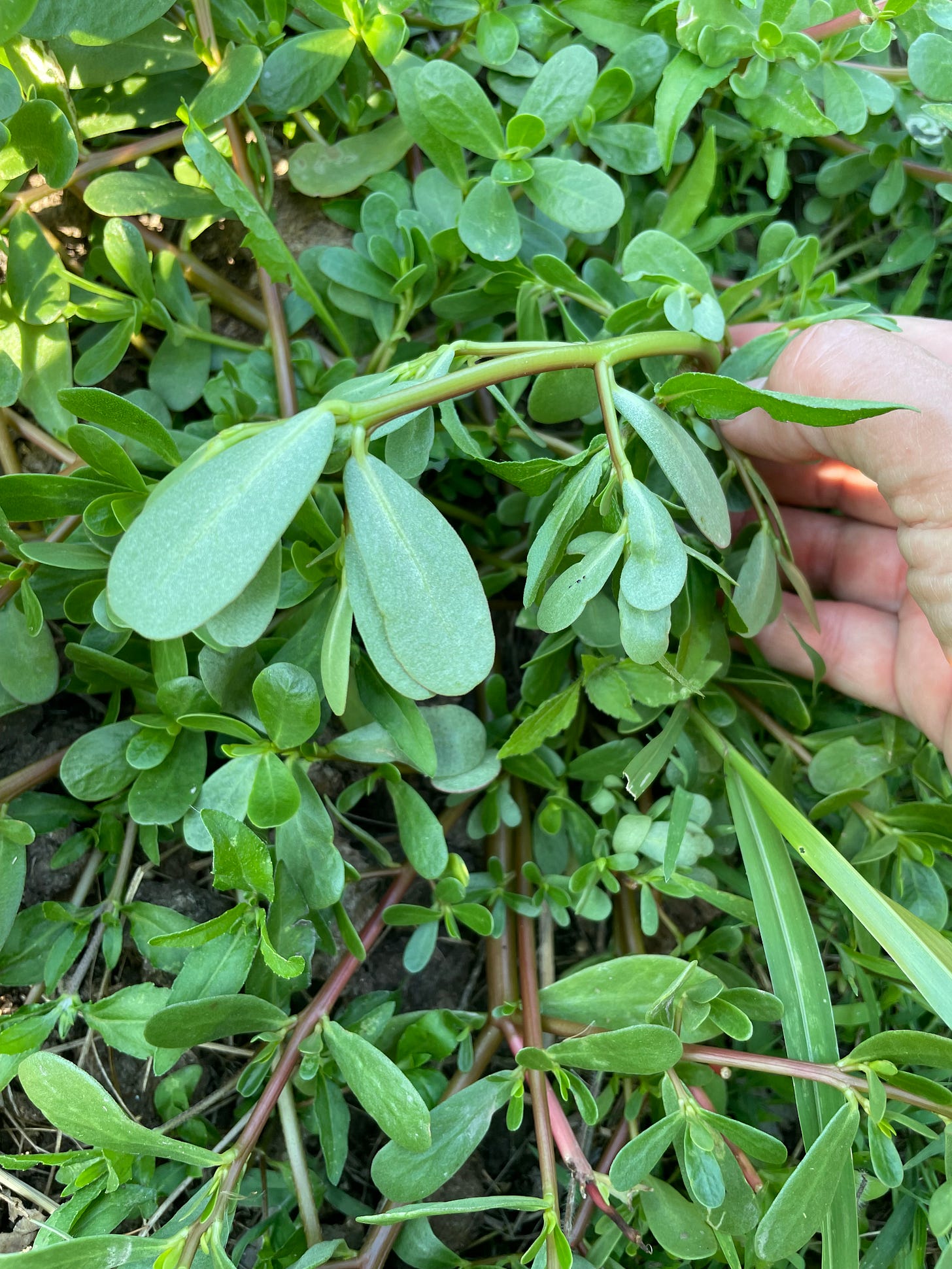
Portulaca oleracea, of the family Portulacaceae, grows in a spreading mat, up to a meter across frequently low to the ground, though some branches might lift themselves 6 or 8 inches up when water is plentiful. Fleshy, succulent leaves can reach over 2 inches (6 cm) in length and perhaps 2/3 inch (15 mm) wide. Leaves appear opposite, and often alternately, emerging directly from glabrous (hairless) stems ranging from green to deep magenta. Leaf shape is called obovate (sort of oval on the large end, and narrower where it attaches to the stem) or spatulate - just check the pictures :-D .
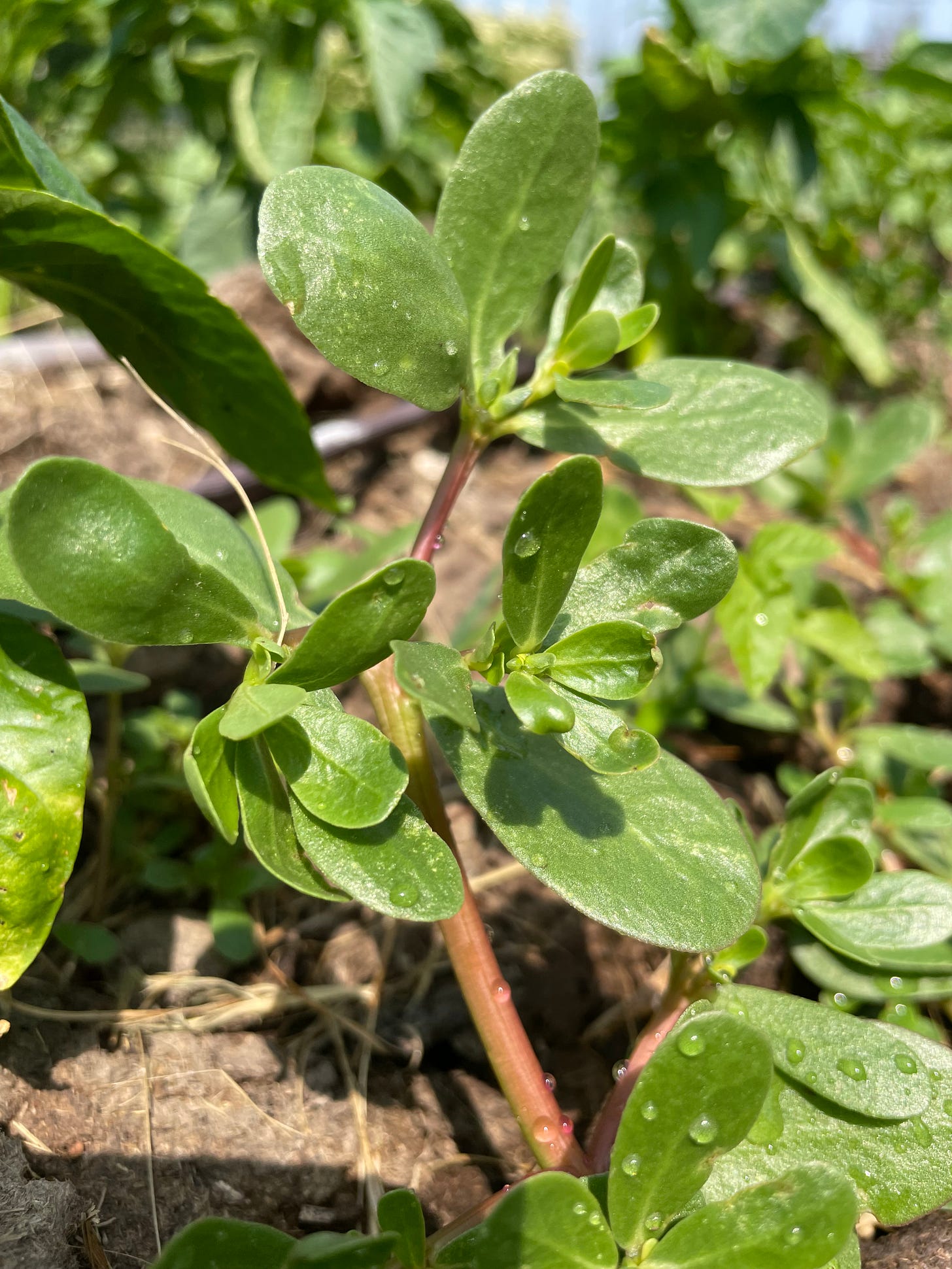
Margins of the hairless leaves are smooth, entire. Young leaves can be tinted maroon, and a trace of this color can remain on older leaves in bright sunlight.
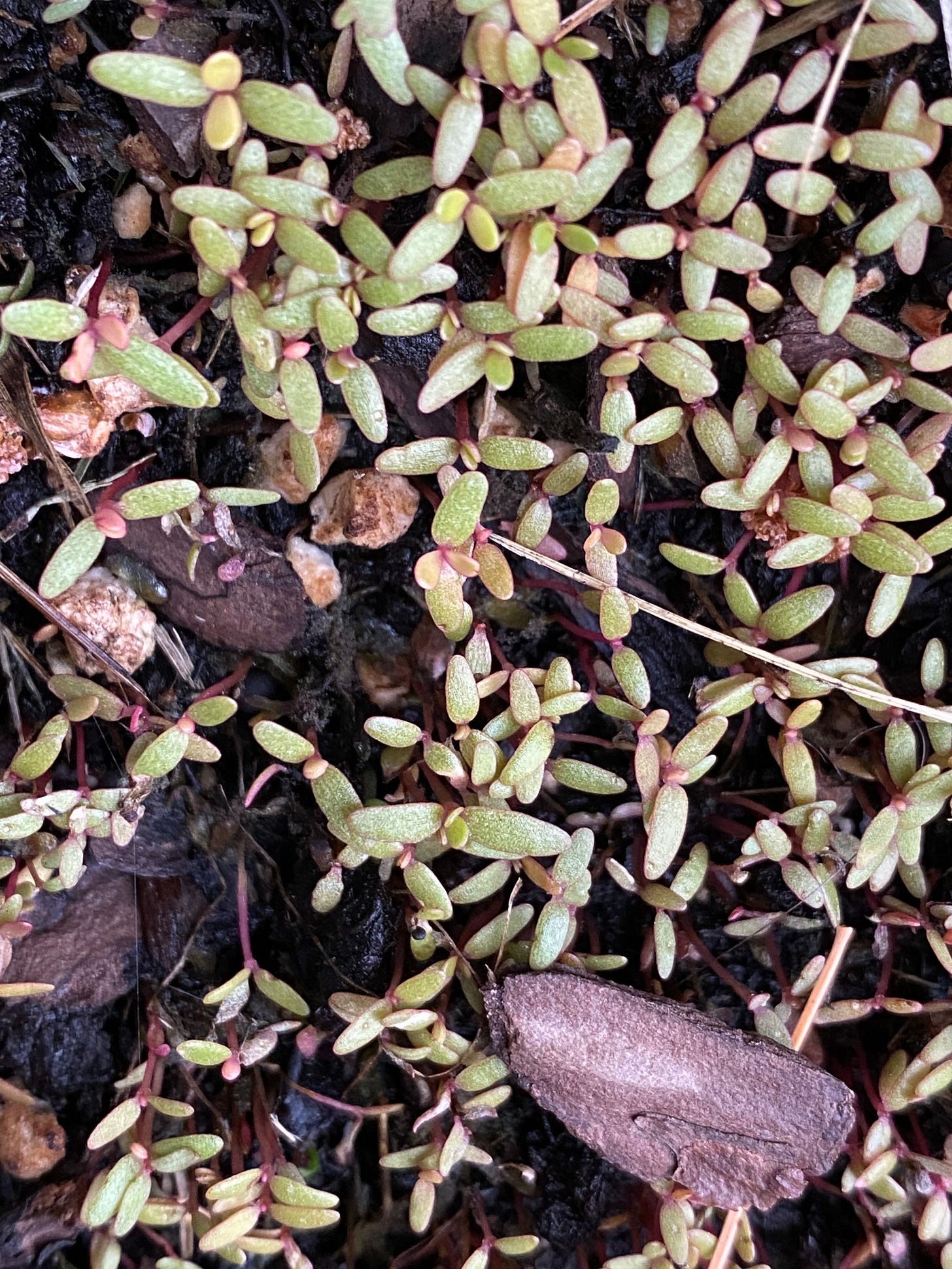
At the flowering tips, whorls of 2 -5 leaves might form. Flowers arise at the tips, each with 2 sepals joined at the base. There are 4-6 petals, and up to 20 stamens. Flowers of the wild growing weed are only about 1/4 inch, (6mm) across, though some cultivated strains have larger flowers. Until our weeds flower, Check here to see a good image and the comparative size. Tiny black seeds are about 0.6 millimeter across, and evoke the image of a spikey snail shell. Each plant might make a couple hundred thousand seeds, which are saved in the soil seed bank for up to 40 years. The majority of seeds have been found to remain viable after passage through the top ends, and out the rear ends of birds and deer. This weed tolerates poor soil and drought conditions, so you can reap its benefits year after year, even when times are difficult. Purslane can be easily propagated by stem cuttings, if you’d like to relocate it or take some indoors with you. Taxonomically, the ‘splitters’ have not gotten a strong hold of our purslane. The general idea is that physical differences among groups of this plant are not stable, and environmental changes influence the morphology quite a bit, including flower size and shape, and seed characteristics. People throughout the world benefit from this widely dispersed weed, which occupies hardiness zones form 2a to 11b. It grows as an annual in temperate zones, and can be perennial in tropical areas.
Lookalike spurge, for example, hairy spurge, Euphorbia vermiculata, is a ‘do-not-eat’ which has much smaller leaves, thinner hairy stems, and exudes white milky sap if you break the stem. We’ve seen a few different spurge species at weedom, including the one below.
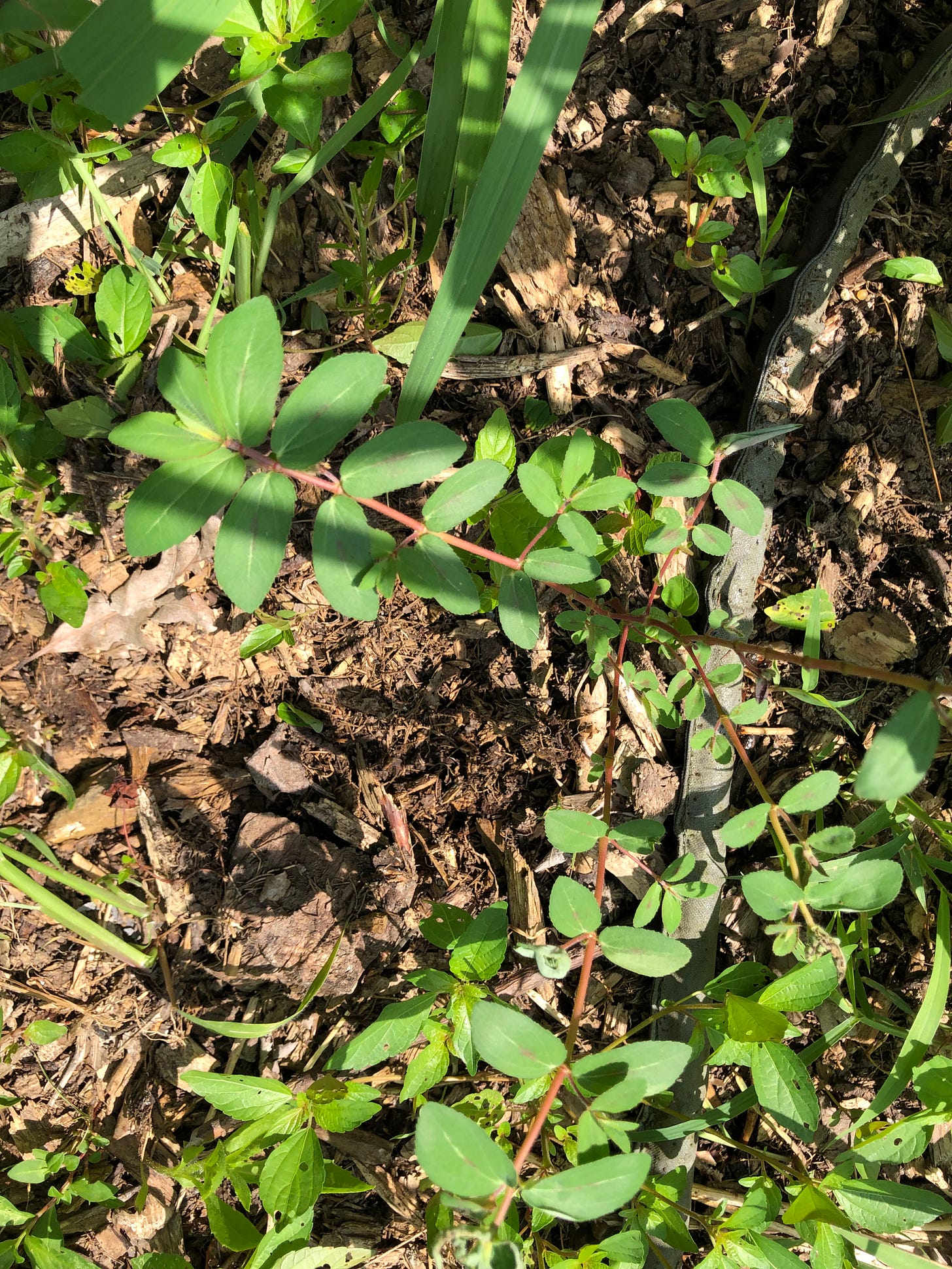
There are some ornamental, large flowered purslane strains which are sold for addition to landscapes, to tolerate dry rocky soil. Some of these are actually another species, Portulaca umbraticola. The wild, edible Portulaca produces very small yellow flowers starting in June or July in our region, (northmost zone 6, midwest U.S.). Taxonomically, the splitters have not gotten a hold of our wild purslane. Lately, the idea seems to be that the physical differences among groups of this plant are not stable, and environmental changes influence the morphology quite a bit, including flower size and shape, and seed characteristics. So there’s not a consistent basis for naming new species.
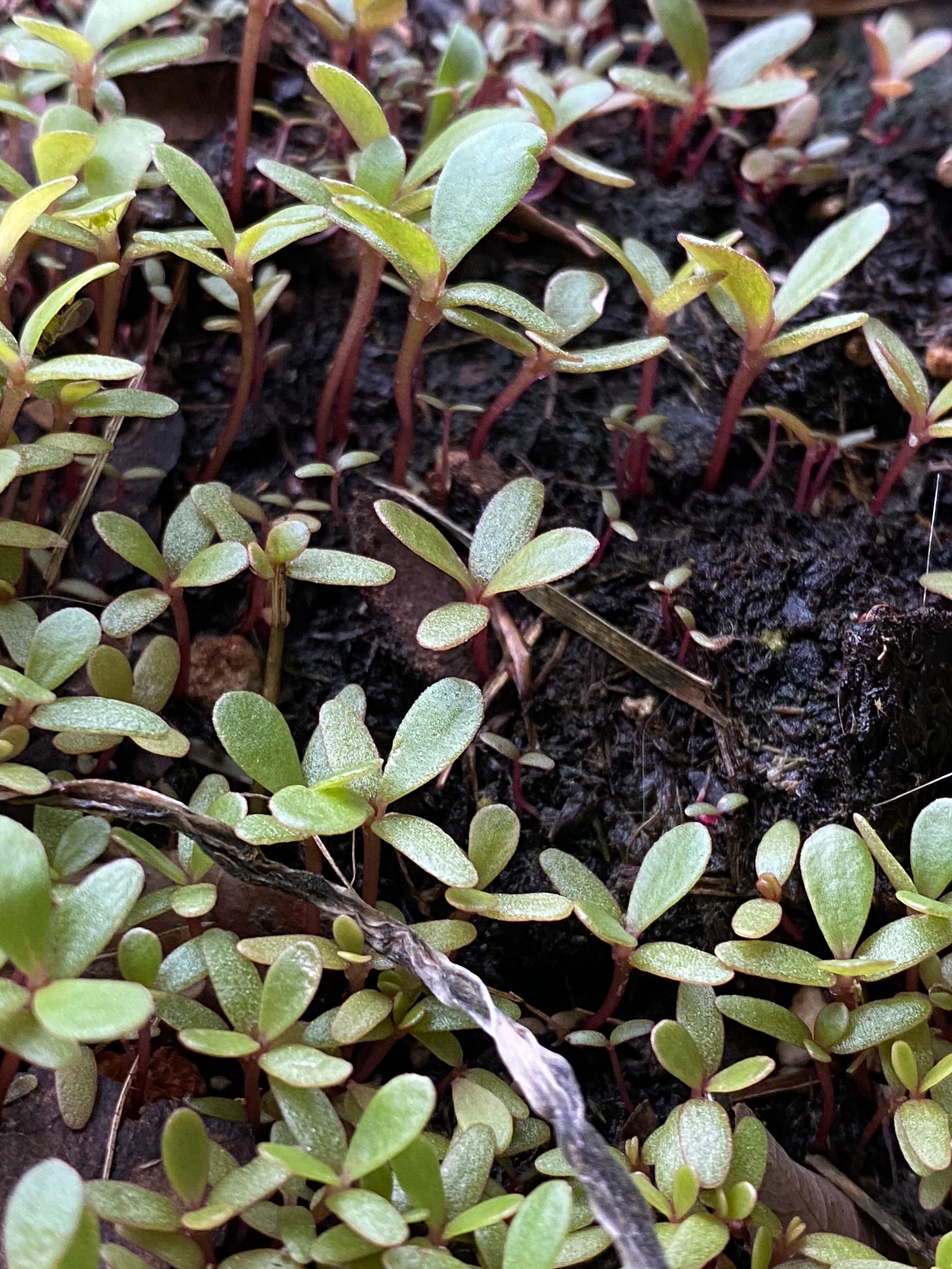
When you find purslane, grab a couple cuttings, preferably before they flower and stick them into a pot of soil. They’ll take root pretty easily. Keep an eye on your plants until they flower and set seed. After the seed capsules dry a bit, open them up and collect some seeds. They’ll be dark brown or black when they’re “done”. Try to start some of your own microgreens. The seeds need light to sprout, so spread them on top of the soil and tamp them down, but don’t cover them.
Portulaca oleracea has a mildly lemony, salty, taste which can accompany almost any other food. It can be eaten raw, or sauteed , (which is usual at weedom), boiled, fried, pickled, as tempura, etc. Since we just had some great tzatziki sauce at the time of writing, we should mention that as a good way to utilize some raw purslane. Use 2 cups real Greek yogurt with the full fat content, because fat = flavor! Strain away any excess liquid from the yogurt. Grate an English cucumber or a couple baby cucumbers (less seedy), washed but not peeled, into a bowl. strain out all the juice. (You can use salt on the grated cucumber to extract more of the water, if you want drier cucumber and thicker tzatziki mix.) Add the strained cucumber to the yogurt. Add a couple cloves of finely grated garlic, and a little salt and pepper to taste. Add 1/2 to 3/4 cup of chopped purslane leaves. Using some skinny, chopped purslane stems is OK, but the fat stems are too chunky. Add a little lemon juice to your mixture, according to taste. Smell some fresh dill or oregano or thyme to see what fits your mood, or the type of food you’re pairing with the tzatziki sauce. Pick one of those herbs, chop it up and add 1 or 2 tablespoonsful to your mix. A dash of olive oil can be incorporated if desired. Stir well and refrigerate it awhile to let the flavors blend. Use this sauce on almost anything or as a dip.
How much Purslane can you eat? The total oxalic acid content of our weed is about twice that of spinach. However purslane leaves, which contain the highest proportion of the oxalic acid, (compared to stems and flower buds) have mostly the insoluble form, which is not absorbed from the gut, into the body. For most people, the amount of total oxalic acid in the vegetables they consume is not well correlated with the concentration found in the urine. The human body itself produces oxalic acid. Gut flora are major determinants of calcium oxalate absorption from the diet into the body. Acidic urinary pH highly influences the potential for kidney stone formation. Eating vegetables tends to counteract urinary acidity.
A lower oxalic acid diet is a consideration for the subset of people who are prone to forming kidney stones. This might include those who have had gastric bypass surgery, people with specific kidney issues, parathyroid dysfunctions, those who took antibiotics, and have unbalanced gut flora, and/or those who eat a lot of sugar. They could consider eating kale and collards, rather than purslane (or spinach, or almonds or tofu). Pregnant women should be very cautious with purslane because it has the ability to cause uterine contractions, if consumed in significant amounts. Most people could find this weed, and enjoy it regularly, as we do, in normal human proportions, as part of a meal. It tastes great, and offers almost all of the essential amino acids, as well as vitamins, minerals and alpha linolenic acid which are needed for good health.
After this growing season, we’ll tell you more about the previously mentioned medicinal constituents of purslane, plus kaempferol, quercetin, apigenin, myricetin, luteolin, genistein, genistin, and the anti-microbial portulosides. Numerous traditional uses of this excellent weed are supported by its known molecular productivity.
Questions, comments, advice? Tell us what you think! Thanks for reading, and spreading the word!
Where we dig
1. de la Forêt R, Han E. Wild Remedies - How to Forage Healing Foods and Craft Your Own Herbal Medicine. Hay House Inc.; 2020. https://openlibrary.org/books/OL28333721M/Wild_Remedies
2. Stewart Robertson D. The function of oxalic acid in the human metabolism. Clinical Chemistry and Laboratory Medicine. 2011;49(9). doi:10.1515/CCLM.2011.238
3. Thayer S. The Forager’s Harvest - A Guide to Identifying, Harvesting, and Preparing Edible Wild Plants. Forager’s Harvest Press; 2006. https://openlibrary.org/books/OL8588402M/The_Forager's_Harvest
4. DerMarderosian A, Buetler J. Review of Natural Products. 8th edition. Lippincott Williams & Wilkins; Facts and Comparisons; 2014. https://openlibrary.org/books/OL27960482M/Review_of_Natural_Products
5. Jy S, Sa P, Khan J. Research and Reviews: Journal of Unani, Siddha and Homeopathy Khurfa (Portulaca Oleracea Linn.) in Unani System of Medicine and Phytopharmacological Studies: A Review.; 2017.
6. Purslane: Pictures, Flowers, Leaves & Identification | Portulaca oleracea. Accessed June 19, 2023. https://www.ediblewildfood.com/purslane.aspx
7. IUCN. Portulaca oleracea: Diop, F.N. & Naas, M.: The IUCN Red List of Threatened Species 2020: e.T164001A65924501. Published online March 17, 2020. doi:10.2305/IUCN.UK.2020-3.RLTS.T164001A65924501.en
8. CABI. Portulaca oleracea (purslane). CABI Compendium. 2021;CABI Compendium:43609. doi:10.1079/cabicompendium.43609
9. Portulaca oleracea (Common Purslane, Garden Purslane, Little Hogweed, Little Hog Weed, Moss Rose, Pigwee, Pigweed, Portulaca, Purselane, Purslane, Pusley, Red Root, Rock Moss, Verdolaga, Wild Portulaca) | North Carolina Extension Gardener Plant Toolbox. Accessed June 19, 2023. https://plants.ces.ncsu.edu/plants/portulaca-oleracea/
10. Portulaca oleracea - Plant Finder. Accessed June 19, 2023. https://www.missouribotanicalgarden.org/PlantFinder/PlantFinderDetails.aspx?taxonid=285506
11. Nemzer B, Al-Taher F, Abshiru N. Phytochemical composition and nutritional value of different plant parts in two cultivated and wild purslane (Portulaca oleracea L.) genotypes. Food Chemistry. 2020;320:126621. doi:10.1016/j.foodchem.2020.126621
12. Palaniswamy UR, Bible B. Oxalic Acid Concentrations in Purslane (Portulaca oleraceae L.) is Altered by the Stage of Harvest and the Nitrate to Ammonium Ratios in Hydroponics.
13. Poeydomenge GY, Savage G. Oxalate content of raw and cooked purslane. International journal of food, agriculture and environment. Published online 2007. Accessed June 20, 2023. https://www.semanticscholar.org/paper/Oxalate-content-of-raw-and-cooked-purslane-Poeydomenge-Savage/1cd6cd9cb9ea10a70eab8cc685c034b0b2ff7ea8
14. Moreau AG, Savage GP. Oxalate content of purslane leaves and the effect of combining them with yoghurt or coconut products. Journal of Food Composition and Analysis. 2009;22(4):303-306. doi:10.1016/j.jfca.2009.01.013
15. Bsc SN, Gp Savage Bsc(hons), PhD, Nz Reg Nu. Oxalate content of foods and its effect on humans. Asia Pacific Journal of Clinical Nutrition. 1999;8(1):64-74. doi:10.1046/j.1440-6047.1999.00038.x
16. Grieve M. Modern Herbal. Echo Point Books & Media, LLC.; 2015. https://openlibrary.org/books/OL36722889M/Modern_Herbal
17. Lawn and Turfgrass Weeds: Common Purslane (Portulaca oleracea L.). Accessed June 20, 2023. https://extension.psu.edu/lawn-and-turfgrass-weeds-common-purslane-portulaca-oleracea-l
18. Albrecht S, Brandl H, Schönfels C. Human Oxalate—Really Just an End-Product of Metabolism? Angew Chem Int Ed Engl. 1994;33(17):1780-1781. doi:10.1002/anie.199417801
19. Ganora L. Herbal Constituents, 2nd Edition - Foundations of Phytochemistry. Lulu Press, Inc.; 2021. https://openlibrary.org/books/OL35083771M/Herbal_Constituents_2nd_Edition
20. Farre M. FATAL OXALIC ACID POISONING FROM SORREL SOUP. The Lancet. 1989;334(8678-8679):1524. doi:10.1016/S0140-6736(89)92967-X
21. Traxer O, Huet B, Poindexter J, Pak CYC, Pearle MS. Effect of Ascorbic Acid Consumption On Urinary Stone Risk Factors. Journal of Urology. 2003;170(2):397-401. doi:10.1097/01.ju.0000076001.21606.53
22. Wang C, Liu Q, Ye F, et al. Dietary purslane (Portulaca oleracea L.) promotes the growth performance of broilers by modulation of gut microbiota. AMB Express. 2021;11:31. doi:10.1186/s13568-021-01190-z
23. Selçuk SN, Gülhan B, Düzova A, Tekşam Ö. Acute tubulointerstitial nephritis due to large amount of sorrel (Rumex acetosa) intake. Clinical Toxicology. 2015;53(5):497-497. doi:10.3109/15563650.2015.1033061
24. Seo Y, Shin J, Cha H, et al. A New Monoterpene Glucoside from Portulaca oleracea. Cheminform. 2004;35. doi:10.1002/chin.200410167
25. Hunan Zhong yi yao yan jiu suo, ed. A Barefoot Doctor’s Manual. Rev. & enl. ed. Cloudburst Press ; distributed to the trade in the U.S.A. by S. Greene Press; 1977.
26. 20 Ways to Eat Purslane - Our Permaculture Life. Accessed June 21, 2023. https://ourpermaculturelife.com/20-ways-eat-purslane/





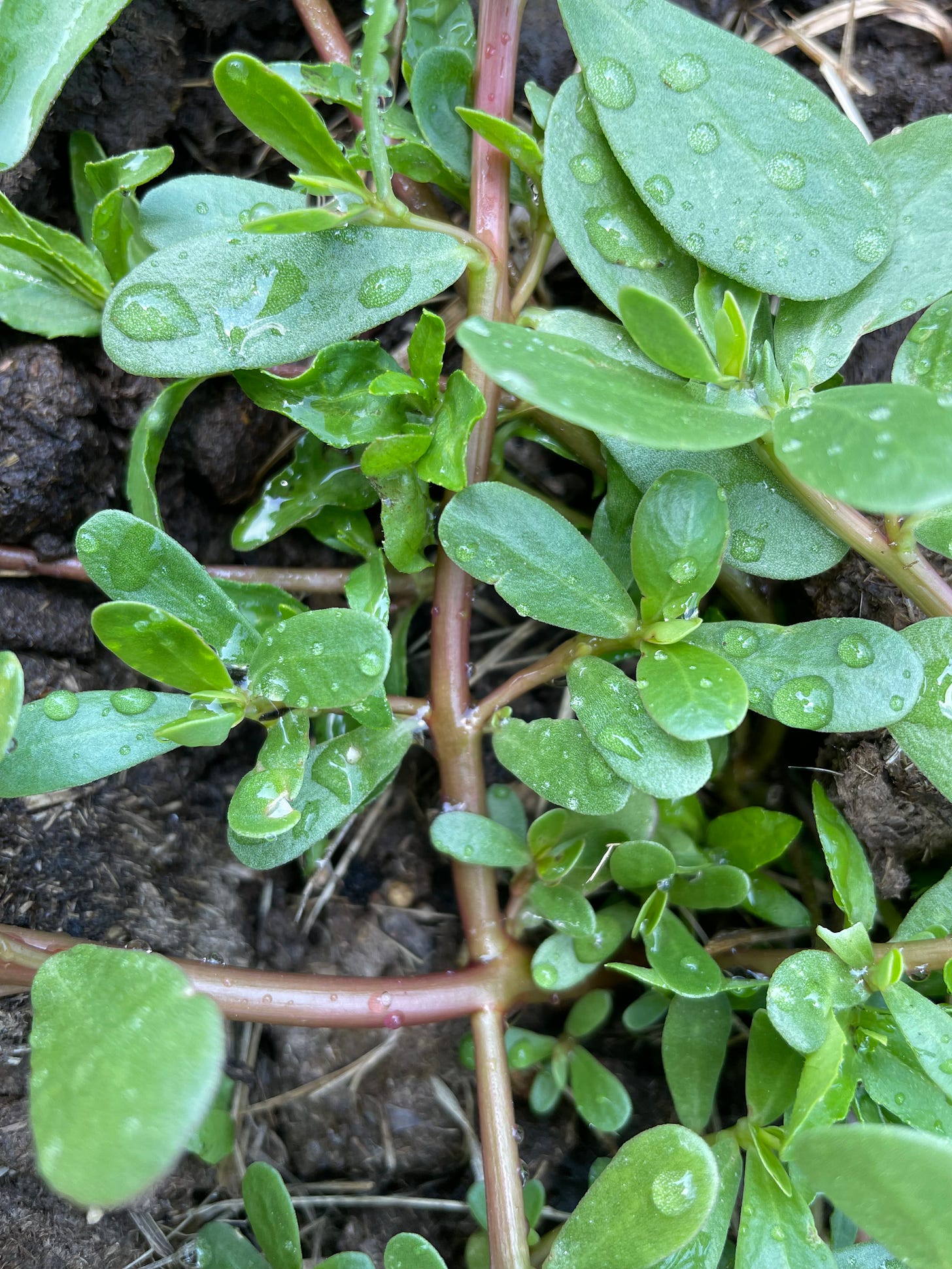

I lived on a beach in Crete for a month, long ago, and the lady running the beach restaurant put purslane in her Greek salad. Yum! I miss it. So pretty, too. Have to get some seeds.
Great advice on spurge. I haven't encountered any spurge that I would mistake for purslane because the spurges around here are not that similar to purslane. But, some I have seen in photos could fool people.